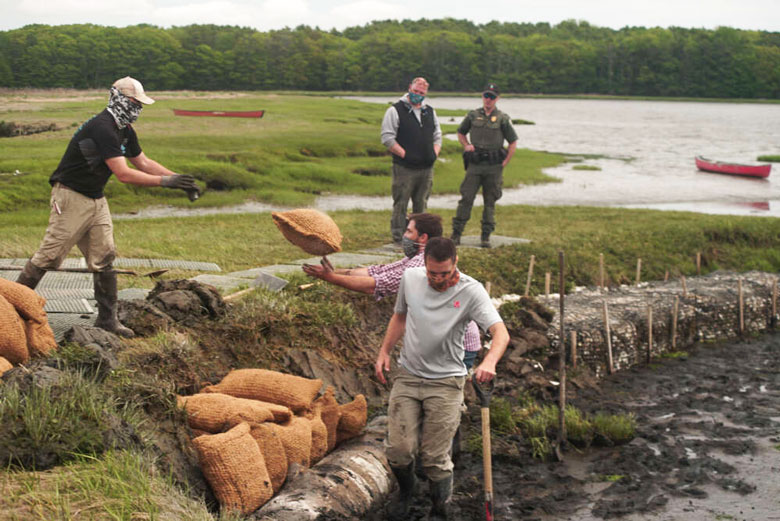Mainers are familiar with the challenges facing our rocky shores—rising sea levels, shoreline erosion, and increasingly intense storms. We’ve seen these impacts firsthand over our lifetimes as well as in single storm events such as last winter’s significant coastal erosion.
The state’s geological survey reports that January’s storms caused 15- to 30-feet of erosion. With sea levels projected to rise by 1.6 feet here over the next 25 years, compared to a national average of 12 inches, immediate action is crucial.
Millions of dollars are flowing from federal and state funds to help Mainers enhance our climate change readiness. As we figure out what to do, it is critical to have a clear vision for our future. By necessity, we will need to blend a bunch of strategies together. Here are some of those options:
For Maine’s rocky shores, offshore seaweed habitats and oyster reefs can effectively reduce wave energy.
One strategy is managed retreat, which involves strategically relocating people, buildings, and assets away from vulnerable areas. This can be implemented through setback policies, zoning restrictions, or incentive programs.
Managed retreat is a proactive approach compared to the reactive and often chaotic forced relocation due to massive or chronic storm damage.
Many communities and entire countries around the world are designing and implementing managed retreat or managed realignment. For instance, New York has undertaken several projects to address coastal risks, including the creation of new parks and green spaces that serve as flood buffers, and the development of “resilient neighborhoods” which involve relocating vulnerable infrastructure and integrating flood protection measures into urban planning.

Entire communities are designing their retreat. The threat of rising sea levels and storm surge induced the U.K. village of Fairbourne to begin a multi-year program to relocate 850 residents and their houses and business. The area will then be turned back into a tidal salt marsh—a nature-based solution to shoreline buffering.
Nature-based solutions use natural systems like barrier islands, salt marshes, and oyster reefs to mitigate coastal hazards and offer various environmental and socio-economic benefits.
For Maine’s rocky shores, offshore seaweed habitats and oyster reefs can effectively reduce wave energy. Restored kelp forests in Norway have cut wave height by up to 50% and wave energy by 70-80%, enhancing shoreline stability.
Oyster reefs provide similar benefits. Restoring them averages $2,260 per hectare, significantly cheaper than traditional structures like bulkheads, jetties, and breakwaters, which can cost over $1 million per hectare.
Engineering solutions abound, like floating structures. Floating roads, bridges, buildings are all being built around the country and world. Most of Maine’s aquaculture farms and of course many wharves float, but what if we expanded them and reduced the amount of fixed infrastructure? Floating infrastructure can move with the sea level, be easily expanded or modified over time or retracted in big storm events.
Finally, there are innovative options that blend natural systems with traditional engineered structures. These solutions are going to be useful for protecting infrastructure that needs to remain on the shore—think working waterfront and parts of large cities that are difficult to move.
In Boston, the exterior of seawalls, pilings, and various concrete shoreline protection structures are being covered with textured surfaces that marine plants and animals make homes in, thereby enhancing marine biodiversity. In New York City, oysters are being used to populate artificial breakwaters with a native ecosystem, reducing storm impact and improving water quality.
Both examples produce benefits such as supporting fish habitat and water quality.
By combining these strategies across a range of scale and use, we can shape a resilient future for our shorelines. Doing so will require an integrated strategic planning process that addresses the challenges of climate change through a comprehensive systems-based approach. It demands the development of adaptive solutions that can be implemented at various levels, blending large-scale coastal and individual property options.
Integrated adaptive planning requires collaboration among governments, landowners, businesses, non-governmental organizations, and other relevant stakeholders. Prioritizing resilient and adaptive measures will help mitigate the risks to coastal regions while protecting and enhancing the value of coastal zones.
Jennifer Seavey is chief programs officer for Island Institute, publisher of The Working Waterfront. She may be contacted at jseavey@islandinstitute.org.





